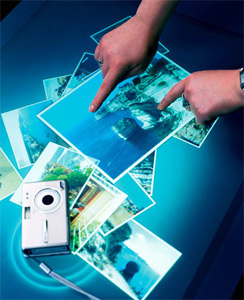Microsoft's “surface” revolution
Not so long ago, Microsoft announced another device, which, according to the Redmond, should make another revolution. We are talking about the "surface PC" Milan - a computer in the form of a coffee table running Windows Vista, which is completely devoid of the usual controls, such as a mouse and keyboard. Instead, the control will be carried out using the touch screen, and several users will be able to work with Milan at the same time.

The basis of the user interface is a 30-inch touch screen, the image on which is projected by a specially developed DPL processor. Five infrared cameras are responsible for tracking all clicks and touches on the surface of the "little table". Most interestingly, Milan provides a really “tangible” way to work with information. Users can literally drag and drop files or images on the surface of the "table" without resorting to using a mouse or keyboard.

The original Domino technology used in Milan also deserves attention. It is built on the principle of a bar code and allows (by reading a pattern of black and white stripes from a special sticker on a device) to identify any Domino-compatible gadget in Plug-n-Play mode. For example, you place a camera with a Wi-Fi interface on the surface of Milan, and the system automatically recognizes it and immediately places the photos copied from the USB flash drive on the screen right next to the device. Also interesting is the use of this technology in the service sector and especially trade. So, for example, the choice of a cell phone in a store, if Milan is available there, can happen in principle without a seller. Just select a phone,
In general, Microsoft has clearly prepared many options for applying Milan in various areas of the "national economy". And the closer the release date of this Surface PC to the market (to be expected by the end of 2007), the more information about this will appear in the press. True, for home use Milan is not yet adapted much. And the point is not its functionality (its wagon and small cart), but in price. Redmondians plan to supply the device so far only to commercial organizations and at a price of 5 to 10 thousand dollars.
via gizmodo

The basis of the user interface is a 30-inch touch screen, the image on which is projected by a specially developed DPL processor. Five infrared cameras are responsible for tracking all clicks and touches on the surface of the "little table". Most interestingly, Milan provides a really “tangible” way to work with information. Users can literally drag and drop files or images on the surface of the "table" without resorting to using a mouse or keyboard.

The original Domino technology used in Milan also deserves attention. It is built on the principle of a bar code and allows (by reading a pattern of black and white stripes from a special sticker on a device) to identify any Domino-compatible gadget in Plug-n-Play mode. For example, you place a camera with a Wi-Fi interface on the surface of Milan, and the system automatically recognizes it and immediately places the photos copied from the USB flash drive on the screen right next to the device. Also interesting is the use of this technology in the service sector and especially trade. So, for example, the choice of a cell phone in a store, if Milan is available there, can happen in principle without a seller. Just select a phone,
In general, Microsoft has clearly prepared many options for applying Milan in various areas of the "national economy". And the closer the release date of this Surface PC to the market (to be expected by the end of 2007), the more information about this will appear in the press. True, for home use Milan is not yet adapted much. And the point is not its functionality (its wagon and small cart), but in price. Redmondians plan to supply the device so far only to commercial organizations and at a price of 5 to 10 thousand dollars.
via gizmodo
